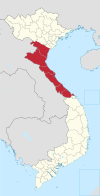Cửa Lò
You can help expand this article with text translated from the corresponding article in Vietnamese. (October 2023) Click [show] for important translation instructions.
|
Cửa Lò
Quận Cửa-lò | |
|---|---|
| Cửa-lò District | |
 | |
 | |
| Coordinates: 18°49′N 105°42′E / 18.817°N 105.700°E | |
| Country | |
| Province | Nghệ An |
| City | Vinh |
| Established | 29 August 1994 |
| Capital | Cửa Lò Ward |
| Area | |
• Total | 29.09 km2 (11.23 sq mi) |
| Population (2024) | |
• Total | 11,884 |
| • Density | 2,531/km2 (6,560/sq mi) |

Cửa Lò is an urban district of Vinh, the capital of Nghệ An province, in the North Central Coast region of Vietnam.
History
[edit]By texts from Thiều Chửu and Dr. Lê Chí Quế, its name Cửa-lò was a classical-Annamese pronunciation of Malayo-Polynesian word keluar or simply kuala which means the point where two rivers join or an estuary.
As of 2018 the town had a population of 75,260.[1] The district covers an area of 28 km2 and it is located 290 km south of Hanoi, 1400 km north of Ho Chi Minh City. In 4th of June 2024, Cửa Lò with four communes of Nghi Lộc district has merged into Vinh.[1]
On October 24, 2024, the National Assembly Standing Committee issued Resolution No. 1243/NQ-UBTVQH15 on the arrangement of administrative units at district and commune levels of Nghệ An province in the period of 2023–2025 and applicabled from December 1, 2024 to present. Accordingly, merging all 29.09 km2 of natural area and population size of 11,884 people of Cửa Lò Town entering Vinh city. It would enjoyed the regulation of urban district inside Vinh.
Culture
[edit]Under the aid of the SEV block in the 1980s, Cửa Lò went from a poor fishing village to become the leading eco-tourism and resort area in Vietnam. There are many beautiful scenes landscapes this district.
Landscapes
[edit]- Hòn Ngư Island
Hòn Ngư Island is located in the sea, more than 4 km from the shore. The island consists of two small islands. The higher island is 133 m above sea level at its highest, with the lower island being 88 m above sea level at its highest. It has an area of 2.5 km2, convenient for sightseeing. On the island there is the so-called Bai Pagoda, built in the 13th century with pagodas and temples; the temple has an upper pagoda and a lower pagoda, and each pagoda has 3 roofs with yin and yang; the beams are carved with sacred objects (dragons, unicorns, turtles and phoenixes), while the garden has many natural green trees such as porcelain trees, fish poison trees, duoi trees and a fresh water well called Jade Gem. The temple has two fish poison trees, both about 700 years old. Currently, there is a project to build a cable car that will connect the island to the mainland.
- Cửa Hội
Located 5 km from Cửa Lò along the beach, Cửa Hội is the place where the Lam River flows into the sea. From here, Hòn Ngư Island can be seen directly. This area is full of casuarina, and the sea here is still uncontaminated and quiet different from the busier atmosphere in Cửa Lò from Cửa Hội. It is possible to follow the Lam river bank through the Cham forest (where there is rich vegetation and animal species such as birds and reptiles).
- Bãi Lữ
Bãi Lữ is a resort that contains sea, mountains and a forest.
Traffic
[edit]There are five roads connecting Cửa Lò and the center of Vinh, the capital of Nghệ An. Tourists can take the bus (Nummber 1) to the center square of the city.
Besides, Vinh International Airport is located 14 km from Cửa Lò, and is the fifth busiest airport in Vietnam. From this airport there are flights to and from Ho Chi Minh City, Hanoi, Nha Trang, Da Nang, Buon Ma Thuot, Pleiku and a few international flights connecting Vientiane and Bangkok.
See also
[edit]References
[edit]- ^ a b "Districts of Vietnam". Statoids. Retrieved March 19, 2009.



